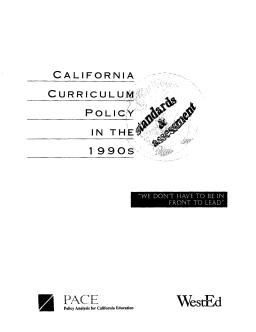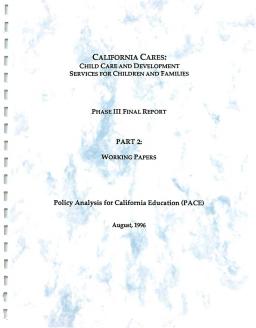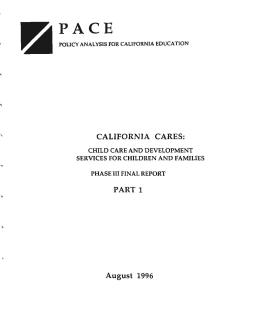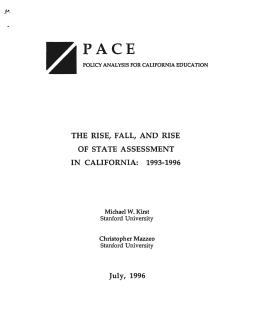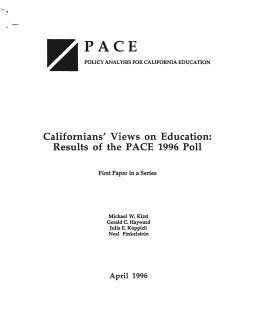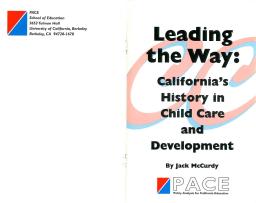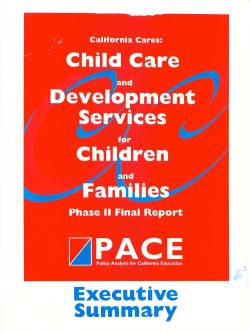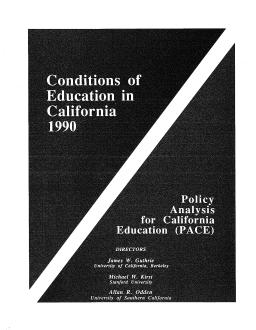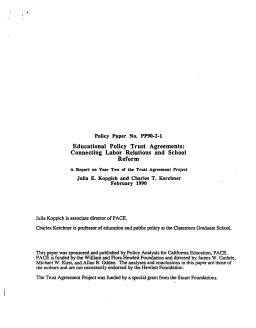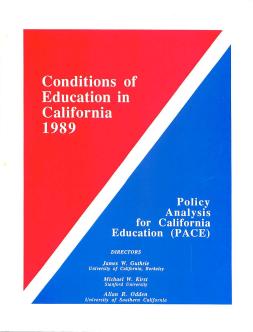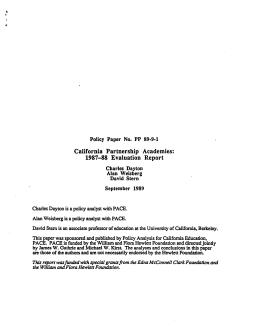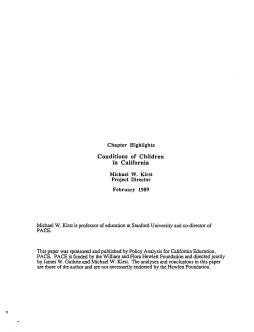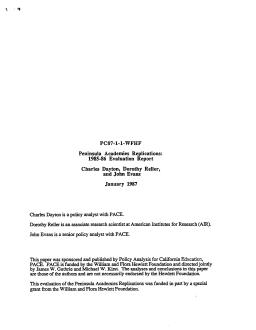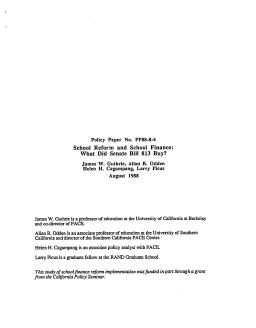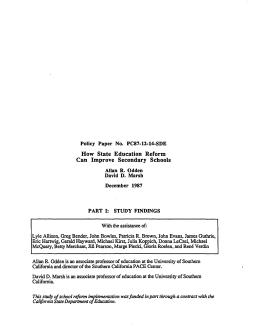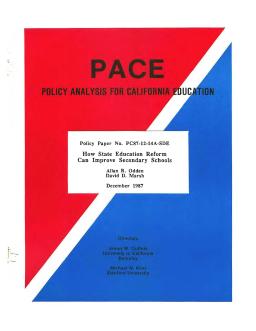Standards and Assessments
Published
Summary
This study traces California's curriculum-related reforms in mathematics and science during the 1990s, examining the role of the California Department of Education and the state's shifting political and policy context. It analyzes the perceptions of state officials, experts, and the public and how they influenced state policy changes. The authors raise questions about problems associated with curriculum policy in California and presents policy recommendations mentioned during interviews and document analysis. The study does not assess the impact of curriculum on school practice.
Child Care and Development Services for Children and Families—Phase III Final Report, Part 2
Published
Summary
Phase III of the California Cares report sought to analyze preliminary recommendations and involve the childcare and development community to redesign policies. Work groups and field representatives discussed proposals for improving services, with over 80 contributors. The project studied nine critical policy restructuring questions and Part Two of the report includes reports from eight tasks and summary information.
Child Care and Development Services for Children and Families—Phase III Final Report, Part 1
Published
Summary
Phase III of the California Cares report aimed to redesign childcare and development policy, with input from the community and representatives from three agencies. Work groups and traditional research projects were conducted to study nine questions deemed critical to policy restructuring. Part II of the report includes working papers for all tasks except state governance, which is included in Phase III.
1993–96
Published
Summary
The California Learning Assessment System (CLAS) was created in 1991 to replace its predecessor and align California's testing system with state curricular frameworks, measure attainment of content through performance-based assessment, and provide individual student assessment. However, objections from various groups led to its discontinuation. CLAS serves as an example of the difficulties in implementing authentic forms of assessment and the politics involved in testing policy reform in the United States.
Results of the PACE 1996 Poll
Published
Summary
A 1996 statewide poll by PACE surveyed Californians on their views and expectations for public schools, informing policy discussions. Results revealed four broad themes and their relevance to ongoing education policy discussions, such as redesigning statewide assessments, reforming traditional school governance, providing public funds for private schools, and complex issues of local control. PACE believes public perceptions should be considered in policy discussions, although education policy should not be solely based on public opinion polls.
California's History in Child Care and Development
Published
Summary
New curriculum manuals have been created to address the expanding field of school-age childcare, including Kids' Time: A School-Age Care Program Guide. Other widely-recognized materials include Just Kids, Preparing for Mass Disasters, and A Guide for Training and Recruiting Child Care Providers to Serve Young Children with Disabilities. The benefits of childcare include fully-employed parents, self-sufficient families, and children who succeed in school due to the aid of childcare programs. Reducing Exceptional Stress and Trauma, a guide on coping with violence, will be published this year.
Child Care and Development Services for Children and Families—Phase II Final Report Executive Summary
Published
Summary
The California Cares Project, conducted by PACE for the California Department of Education, Social Services & Office of Child Development & Education, culminates in this report. The project was initiated in response to AB 2184, which sought to consolidate all childcare and development programs to streamline the system. The report is divided into two parts: Part I analyzes current obstacles to a seamless system and Part II presents a conceptual model and decision procedure for program and funding allocation and governance. Phase III will refine recommendations and work towards implementation.
Child Care and Development Services for Children and Families—Phase I Final Report
Published
Summary
The California Department of Education, Social Services, and Governor's Office of Child Development and Education selected PACE to analyze issues and options for improving California's childcare system. PACE will produce a report with optional approaches for improving access, quality, and funding of childcare services, including alternative systems and policy models. Phase I includes analysis of childcare issues and programs, literature reviews, and experiences of other urban states. This report summarizes Phase I's work.
Published
Summary
This is the ninth edition of Conditions of Education in California. In this volume, PACE has compiled information on current critical issues in state education policy and presented them within the context of major policy developments. "Evolving Context" introduces the current issues in the state and sets the stage for the remaining chapters, which are Assessment and Achievement, Finance, Teachers and Teaching, Integrated Children's Services, Child Care and Development Services, and School-to-Work.
Published
Summary
The seventh edition of Conditions of Education in California by PACE focuses on education policy issues in a national context. The report analyzes California's education data by placing it in multi-state, national, and international contexts. The report's first three chapters analyze evolving education policy issues, Sacramento political dynamics, and student achievement. The remaining three chapters provide longitudinal data on student enrollment, finance, and system characteristics. The report aims to provide a continuing picture of education in California.
Published
Summary
CA's education system is affected by external factors like shifting demographics, declining economics, and intensifying politics, limiting the traditional routes of local decision-making and property taxation. Although some districts show excellence and commitment, creating and sustaining a statewide education system to meet 21st-century expectations is difficult without a comprehensive reform plan. Political conflict over revenue earmarking and school reform distracts from education improvement. This report describes and analyzes these issues, suggesting a comprehensive set of solutions.
Connecting Labor Relations and School Reform: A Report on Year Two of the Trust Agreement Project
Published
Summary
The Trust Agreement Project, initiated in September 1987, is a joint effort of 12 California school districts and their teachers' unions. It enables teachers and school management to develop agreements on professional issues beyond the traditional scope of collective bargaining. The agreements cover topics like teacher evaluation and curriculum development, and aim to enhance educational capacity by promoting collective responsibility for educational processes and outcomes. The project appears to be altering decision-making processes and encouraging collaboration between unions and management.
Published
Summary
The study examines the Partnership Academies in California, which are designed to reduce high school dropout rates among at-risk students. Academies combine high school curriculum, technical courses, and support from local businesses, with funding based on student outcomes. Survey results indicate that Academy students had a lower dropout rate than comparison group students, were more likely to attend college, and earned higher wages while working and studying. Graduates from both groups reported being fairly satisfied with their high school preparation and achievements since graduation.
Published
Summary
This is the fifth edition of Conditions of Education in California. Over time, the content and format have changed in keeping with suggestions made by readers. This publication is based upon compilations and syntheses of information collected by other agencies and individuals. These sources are noted throughout the text. We wish here to express our appreciation to these others upon whose efforts we depend so heavily. Also, PACE undertakes a substantial amount of original data collection and analysis. We make specific mention of this throughout the text.
1987–88 Evaluation Report
Published
Summary
This report presents findings from the third annual evaluation of Partnership Academy Programs in CA, a high school-based, state-funded program with a school-within-a-school administrative structure that enrolls at-risk students with academic potential. The program provides students with basic job skills in a promising labor-market field and support from local businesses, including curriculum development, guest speakers, field trips, mentors, and work experience positions. The evaluation addresses the quality of program implementation and the degree to which programs follow the academy model.
A Hypothetical Account and Research Review
Published
Summary
This paper discusses childcare quality and its impact on child development. It highlights the need to consider various factors that contribute to quality and how they affect children's experiences. Presented is a hypothetical day in two different childcare situations to demonstrate the varying experiences children have. The characters and incidents are fictional but based on the author's real observations and experiences in early childhood programs in CA. The author emphasizes the need to promote quality early childhood programs informed by research in child development and early education.
Published
Summary
California's growing child population will require significant increases in public spending, particularly in education due to immigration, working parents, poverty, and family disorganization. Counties and school districts bear the brunt of providing children's services, but cities have greater fiscal flexibility and revenue-raising potential. This paper provides information on county children's services and trends in county budgets to support further research on county financing for children's services.
Chapter Highlights
Published
Summary
This report provides social indicators to evaluate the quality of life for children in California, covering physical and mental health, safety, sexual behavior, academic achievement, and the settings and systems that serve children. Despite most children being healthier and better schooled than in the past, recent polls indicate concern about child-rearing and the likelihood of an expanding educational underclass. The report aims to offer a portrait of the quality of California's children, address gaps in available data, and provide limited policy recommendations.
Graduate Follow-up Survey
Published
Summary
A survey was conducted on the first class of participants in the "Jobs for the Disadvantaged" program and a comparison group six months after graduation. Although the sample size was small, a significantly higher percentage of program participants graduated on time than the comparison group. About half of both groups were in postgraduate schooling, but more program graduates were working. Among those in school, few differences were found. For those working, twice as many program graduates secured work through school, but comparison-group graduates had somewhat higher wages.
1986–87 Evaluation Report
Published
Summary
In the fall of 1985, ten academy programs were established by the State of California as replications of the Peninsula Academies. PACE evaluated these 10 academies in 1985–86. This report presents findings from a second evaluation covering the academies' 1986–87 school year.
Program Successes and Evaluations Under 'Jobs for the Disadvantaged'
Published
Summary
This report discusses the challenges of implementing broad state-level initiatives to reform schools in California, following the passage of S.B. 813 in 1983. While earlier studies showed the formal implementation of these reforms, their impact on local schools and substantive changes remained unclear. The article uses data to answer the question of whether these state-level initiatives can improve local schools, concluding that successful implementation depends on several factors. The evaluations also revealed lessons about conducting evaluations and obtaining necessary data from schools.
Published
Summary
The fourth edition of Conditions of Education in California has expanded its content to include a special features section on education reform processes, along with the previously included sections. The publication is based on compiled information from other sources and original data collection and analysis. The format has been altered to improve readability for a wide range of audiences.
Study Findings
Published
Summary
In 1983, California's Senate Bill 813 aimed to improve the education system by proposing a large number of reforms. However, it lacked a cohesive strategy and proven philosophy. The bill's impact on school districts and schools was unknown, and this study aimed to assess whether selected schools could implement the reform components and whether they contributed to school improvement. The goal was to understand how schools reacted to state mandates and inducements for improvement.
A Preschool Through High School Concern
Published
Summary
This report explores why thousands of students continue to drop out despite the belief that education is necessary for success. By examining dropout characteristics and behavior from preschool through high school, it presents the experience of selected dropout prevention programs. Focusing on the specific act of dropping out may neglect earlier clues, so understanding students' experiences as they progress through grades is crucial for effective prevention strategies.
Background and Technical Appendices
Published
Summary
California's education system faced a decline in the early 1980s, prompting reforms such as a common core curriculum, higher graduation requirements, and tougher academic standards. A Nation at Risk report further pushed for nationwide school changes. California's swift response led to the enactment of Senate Bill 813, a comprehensive education reform program with over 80 policy and program reforms. Several studies showed positive results, but the study in this report aims to determine how state-level education reforms improved local schools.
